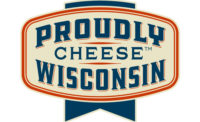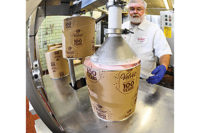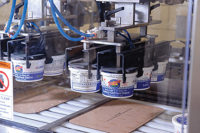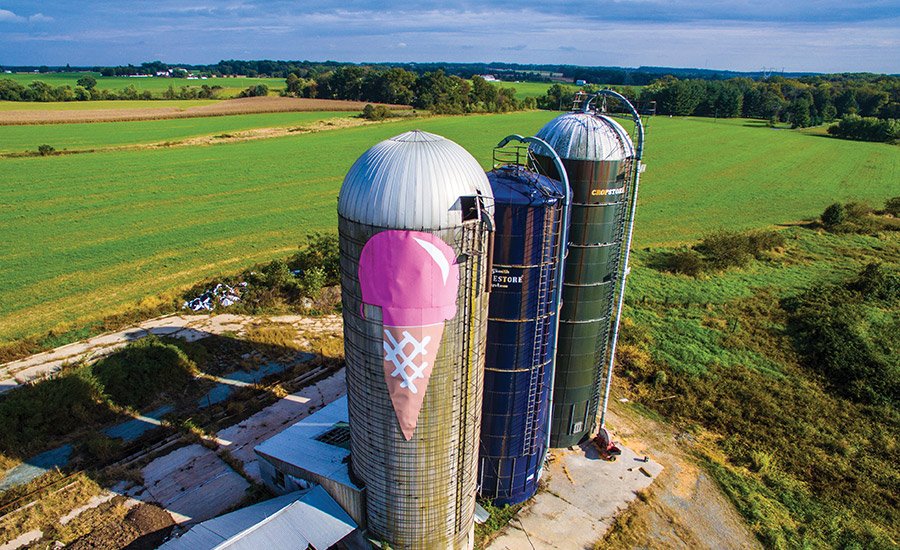From moo to you
Kilby Cream gets fresh: a look inside the dairy processor's operation
Consumers want local, fresh and minimally processed foods. A dairy farmer in rural Maryland said, ‘I can do that,’ and built a plant to process milk and ice cream. Meet the owners of Kilby Cream.

Megan Coleman and her mother Phyllis Kilby sell milk and ice cream in their store in Rising Sun, Md. They make the ice cream and bottle milk in a plant on their dairy farm in Colora, Md. On the wall behind them are photos of the Kilby family, which has been farming for 100 years. All photos by Vito Palmisano.

A production worker inspects ice cream mix at Kilby Cream.

Phyllis Kilby stands with some of the 400 dairy cows she farms in Colora, Md. She and her husband Bill are members of the Maryland & Virginia Milk Producers Cooperative.

A production worker ladles ice cream into a container. Later, graham cracker pieces will be added by hand into this recipe.

Glass bottles move along a conveyor from the washing room to the filler. Kilby Cream fills quarts and half-gallons.

Half-gallon bottles receive a plastic handle. The bottles are cased and then moved to a cold room, where home delivery route drivers will pick their orders.

Milk crates and bottles that have been returned to the plant by home delivery drivers are washed and sanitized.

Milk crates and bottles that have been returned to the plant by home delivery drivers are washed and sanitized.

Milk is sampled in the on-site laboratory. The dairy tests raw milk and finished goods.

Kilby Cream has one of the nine stores on the Ice Cream Trail, a promotion created by Maryland’s Department of Agriculture to support farmstead retail operations.

Kilby Cream has a milk processing plant on its farm in Colora, Md. The dairy processor also makes ice cream here. The Kilbys farm about 400 dairy cows.

Plant Manager Lupe Rosales takes Dairy Foods Editor Jim Carper on a tour of the creamery.












After farming for 100 years, what does a family do to position itself for success into the next century? They add a dairy processing operation.
Bill Kilby’s family has been farming for 100 years. His ancestors had farms in Pennsylvania and North Carolina. In 1961, his parents settled in Cecil County, Maryland. Now Bill and wife Phyllis operate a 400-head dairy farm in Colora, located about an hour northeast of Baltimore.
Their newest venture is dairy processing under the name Kilby Cream. The Kilbys are taking advantage of many of the trends affecting all food processors: consumer demand for healthy and minimally processed foods purchased from local sources who are transparent about their business practices.
At their creamery in Colora, a little community with a population of about 500, the Kilbys bottle fresh milk and churn ice cream. They have a growing home delivery business and a busy ice cream shop. The ice cream store participates in agri-tourism events that show the public where their food comes from. The Kilbys invite school groups to tour the dairy farm. They show them the milking parlor, methane digester and greenhouse, and they talk about the importance of caring for land and streams.
Dairy farming is hard, physical work. Competing in packaged food poses its own set of challenges, especially in dairy. These include going up against food businesses that are far larger, Americans drinking less milk and ice cream being considered a treat and not necessarily a food to eat every day. But the family is determined to succeed in dairy processing.
Value-added dairy
In 2005, in an effort to add value to their milk, they began churning ice cream. The Kilbys opened an ice cream shop and a manufacturing operation on a second farm they own in nearby Rising Sun, Md. Then in 2010, they built a milk processing plant next to the dairy farm in Colora and moved the ice cream processing operation there.
Soon, there will be more than dairy products originating on the farm. The Kilbys are leasing some of their land to the owners of a micro-brewery who are building a processing facility in Colora.
The Kilbys belong to the Maryland & Virginia Milk Producers Cooperative Association, but they keep about 10% of their milk to process into fluid products and ice cream. A big selling point is freshness. Consumers tell the Kilbys that their dairy products taste better than mass-marketed brands, said Tracy Martin, who manages the office. Kilby has nearly 900 home delivery customers plus commercial accounts.
The Kilbys are part of trend in dairy farming: find additional non-farming sources of revenue. They chose the route of producing value-added dairy products.
“We do see more and more members exploring opportunities to direct-market to consumers,” said Amber Sheridan, the director of corporate communications for the Maryland & Virginia Milk Producers Cooperative Association. “I estimate we have about 20 members that do on-farm processing of some sort, from fluid milk and ice cream to farmstead cheeses. For many farmers, on-farm processing and similar diversified ventures have helped many farms survive and prosper.”
Sheridan pointed out an additional benefit of the dairy producer/processor. “They also have become valuable spokespeople in their communities and give consumers a connection with their local farming community,” she said.
To have a farmer talk about animal care as well as the nutritional benefits of milk helps the entire dairy industry.
The Kilbys raise Jerseys, Holsteins and Montbéliardes. It is the higher fat-content in Jersey milk that makes the ice cream and fluid milk products taste so good, Phyllis said. (Years ago, as one holiday season approached, Phyllis told her husband, “Give me something I don’t have to dust.” She woke up on Christmas to find two Jersey cows.)
The creamery employs about 40 full- and part-time individuals, including workers in the processing plant, route drivers and scoopers at the ice cream shop.
The Kilbys, who celebrated their 50th wedding anniversary in October, have four children. Daughter Megan Coleman leads the family’s efforts in value-added dairy processing. (Her two sisters help with the local farmers’ market and her brother is not involved in the operation.)
Before heading up the creamery operation, Coleman taught French in the public schools. She studied French and sociology in college and lived in France for a semester. (The Kilby family has long been interested in the world beyond Cecil County. Bill and Phyllis taught basic agriculture skills in Egypt for six weeks. Several years later a delegation of their students came to Colora to see American dairying practices.)
Maryland’s Ice Cream Trail
Agri-tourism is the fancy name used to describe consumers’ desire to visit the locations where their favorite foods come from, not to mention having fun learning and eating along the way. Napa Valley has its wine tours, Wisconsin has its cheese routes and Maryland has its Ice Cream Trail.
Maryland’s Department of Agriculture, along with the Mid-Atlantic Dairy Association, developed the Best Ice Cream Trail program in 2012 to show the public the importance of dairy farming. Last year, nine dairy farms with on-site ice cream processing operations participated.
The goals of the program are to connect consumers to food producers, help dairy farmers diversify into manufacturing value-added products and to promote dairy foods as a whole, said Mark Powell, the chief of marketing and agricultural development for the Maryland Department of Agriculture in Annapolis. The state has 463 dairy farms that accounted for $173 million in sales in 2015.
Last year’s trail extended 290 miles from Ocean City in the east to Washington County in the west. Powell said more than 200 individuals visited all nine stores. The Department of Agriculture printed a brochure with the location of the stores along with questions visitors can ask farmers, including “How many pounds of milk does it take to produce a gallon of ice cream?” and “Which breed produces the most milk?” Tourists who collect “passport stamps” from all nine shops were eligible to win prizes, including gift certificates and cookbooks.
Powell called the Kilbys “extremely innovative farmers” and said they are adept at using social media and working with local media to bring consumers to their store.
At Kilby’s ice cream store, Coleman organizes a variety of activities. There’s a geocache on the premises to attract those who like to participate in this modern-day treasure hunt. The store is popular for corporate outings and with school groups. On the day Dairy Foods visited, parents were treating their children who had just received flu shots to ice cream cones. In the autumn months, the farm store offers hayrides, a corn maze, bonfires and a sling shot to launch apples as far as possible.
Touring the dairy plant
The dairy had been making ice cream at the store in Rising Sun. But once the bottling plant opened, it moved the ice cream production to Colora. Plant Manager Lupe Rosales took Dairy Foods on a tour of the creamery last fall. Kilby bottles milk on Monday, Tuesday and Thursday. The processing crew makes ice cream mix on the other days. Kilby first tests raw milk in its on-site lab for bacteria. After passing a battery of tests, the milk is ready for processing. The lab also conducts shelf life tests on finished products.
Raw milk from Jersey cows is pumped directly from the milking parlor to the raw room in the processing plant. Milk is run through a high-temperature, short-time pasteurizer and then held in one of four tanks. One tank is for cream and three others for milk. The raw room also contains a separator, homogenizer and mix tank (for the production of chocolate milk). Cocoa and sugar are poured by hand into the mix tank and blended with raw milk. Then this is pumped through the HTST unit.
In a separate room are empty milk crates and glass bottles that have been picked up by the creamery’s home delivery drivers. The bottles and crates are fed into washing machines that clean and sanitize them. The clean bottles are moved to a staging area where they are then placed on a conveyor to the filler.
Kilby’s fluid products consist of whole, 2%, skim, half-and-half, heavy cream, chocolate, 2% chocolate, whole strawberry and egg nog. It also bottles a cream line milk (which is not homogenized).
Back in the production room, pasteurized milk flows to the filler. Kilby Cream uses quart and half-gallon bottles printed with the company’s name and logo. Bottles are filled in two steps to minimize foaming. Then they are capped (a plastic handle is placed on the half-gallon bottles) and are pulled off the line by the filler operator who places them in a crate. The crates are moved to a nearby cooler.
Three drivers service residential customers and two drivers service wholesale accounts, including stores and farmers markets. Drivers pick their own orders from the cooler and load their trucks. The cooler contains other Kilby-made items including butter and honey butter. Drivers also deliver eggs, bacon, cheese and other foods from local suppliers.
Churning ice cream
Ice cream manufacturing is a hand-made operation, and occurs in another part of the processing room. Milk and cream are vat-pasteurized. The mix is poured by hand from buckets into two Italian-made batch freezers. Kilby’s ice cream formats are 2½- gallon paper boxes or plastic tubs, pints and 7-ounce cups. An employee controls the flow of ice cream into containers. Then she adds inclusions by hand. On the day of Dairy Foods’ visit, she added crushed graham cracker pieces to a cinnamon apple pie recipe.
After packaging, the ice cream is placed in a hardening cabinet on the floor of the processing room. Later, containers will be transferred to a deep freezer.
Kilby makes about 50 standard ice cream flavors and 18 seasonal flavors (nine each for spring/summer and fall/winter). Many of the flavor names are cow-themed, including Cownie (vanilla ice cream with brownie chunks and chocolate chip cookie dough) and Fear the Cow (chocolate ice cream with caramel swirl and cashews). The dairy offers three sugar-free ice creams. These are sold at its retail store, where patrons can also order sandwiches, wraps and snacks. Ice cream pints and milk half-gallons are also available for sale. The creamery also sells the ice cream to area foodservice accounts. It does not manufacture any private label milk or ice cream.
Educating the public
Besides serving ice cream, the on-farm store serves to introduce the public to farming, land use and conservation. The Kilbys are staunch supporters of farming and rural life. They have placed both of their farms into a conservation trust to ensure that the land will remain as farms or open space in perpetuity.
The Kilbys also are active in the Maryland & Virginia Milk Producers Cooperative and in local and state government programs. Phyllis Kilby is serving her first term on the co-operative’s board of directors. Bill has been elected to the co-op’s Leadership Council.
Phyllis is a former Cecil County commissioner. She is a past president of the Rural Maryland Council and Bill has served on the executive board. The council is an advocate for economic development, education, health, legislation and other issues important to those in non-urban areas. Phyllis has been involved in governmental commissions on families, aging and the Chesapeake Bay.
Kilby Cream promotes the freshness of its products in its slogan “from cow to cone in two days.” By opening up the dairy farm to visitors and holding events at the ice cream store, Kilby and Coleman are showing consumers the origins of dairy foods. But they are doing much more than that. Mother and daughter are demonstrating how animal care, land stewardship and producing nutritious food are interrelated. And that’s a big feat from a small business.
Looking for a reprint of this article?
From high-res PDFs to custom plaques, order your copy today!


















